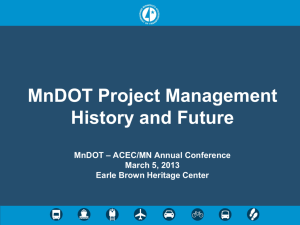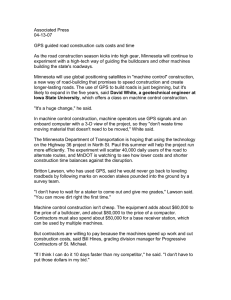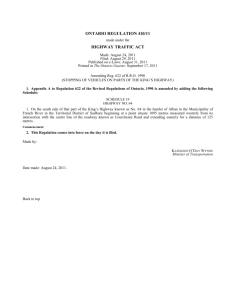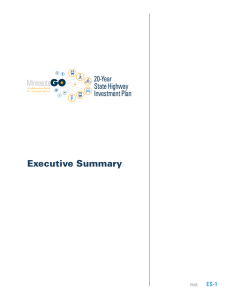RESEARCH SERVICES & LIBRARY Real Estate Value Capture: An Emerging
advertisement
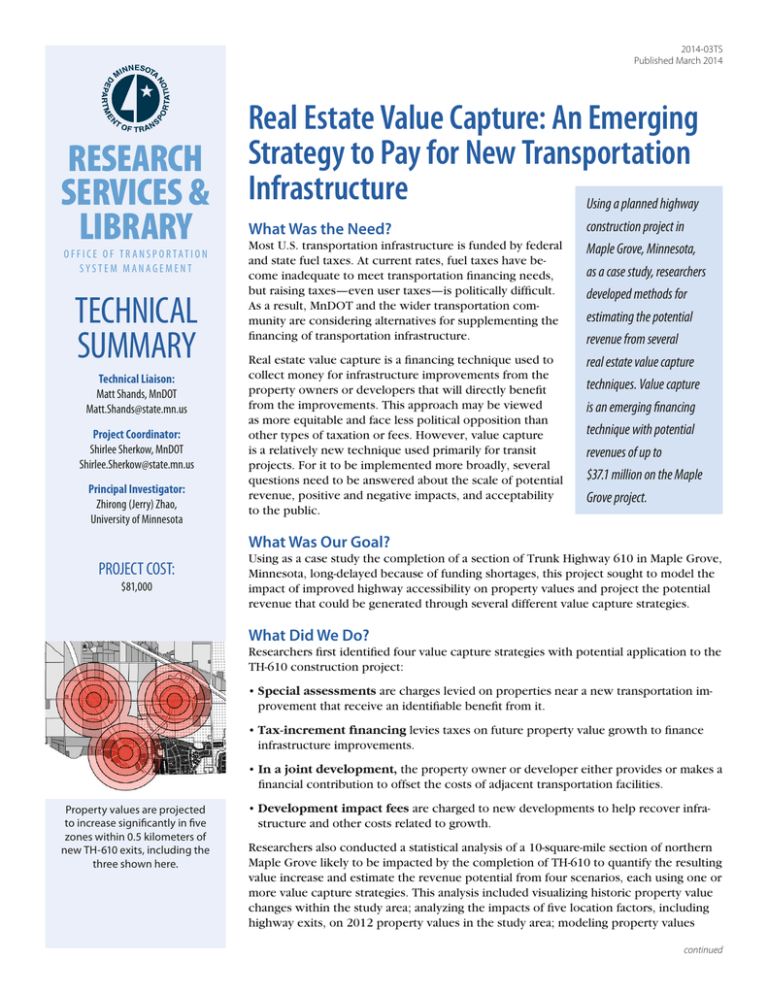
2014-03TS Published March 2014 RESEARCH SERVICES & LIBRARY O FFI C E O F T R A NSP O R TAT I O N SYSTEM MANAGEMENT TECHNICAL SUMMARY Technical Liaison: Matt Shands, MnDOT Matt.Shands@state.mn.us Project Coordinator: Shirlee Sherkow, MnDOT Shirlee.Sherkow@state.mn.us Principal Investigator: Zhirong (Jerry) Zhao, University of Minnesota Real Estate Value Capture: An Emerging Strategy to Pay for New Transportation Infrastructure Using a planned highway What Was the Need? Most U.S. transportation infrastructure is funded by federal and state fuel taxes. At current rates, fuel taxes have become inadequate to meet transportation financing needs, but raising taxes—even user taxes—is politically difficult. As a result, MnDOT and the wider transportation community are considering alternatives for supplementing the financing of transportation infrastructure. Real estate value capture is a financing technique used to collect money for infrastructure improvements from the property owners or developers that will directly benefit from the improvements. This approach may be viewed as more equitable and face less political opposition than other types of taxation or fees. However, value capture is a relatively new technique used primarily for transit projects. For it to be implemented more broadly, several questions need to be answered about the scale of potential revenue, positive and negative impacts, and acceptability to the public. construction project in Maple Grove, Minnesota, as a case study, researchers developed methods for estimating the potential revenue from several real estate value capture techniques. Value capture is an emerging financing technique with potential revenues of up to $37.1 million on the Maple Grove project. What Was Our Goal? PROJECT COST: $81,000 Using as a case study the completion of a section of Trunk Highway 610 in Maple Grove, Minnesota, long-delayed because of funding shortages, this project sought to model the impact of improved highway accessibility on property values and project the potential revenue that could be generated through several different value capture strategies. What Did We Do? Researchers first identified four value capture strategies with potential application to the TH-610 construction project: • Special assessments are charges levied on properties near a new transportation improvement that receive an identifiable benefit from it. • Tax-increment financing levies taxes on future property value growth to finance infrastructure improvements. • In a joint development, the property owner or developer either provides or makes a financial contribution to offset the costs of adjacent transportation facilities. Property values are projected to increase significantly in five zones within 0.5 kilometers of new TH-610 exits, including the three shown here. • Development impact fees are charged to new developments to help recover infrastructure and other costs related to growth. Researchers also conducted a statistical analysis of a 10-square-mile section of northern Maple Grove likely to be impacted by the completion of TH-610 to quantify the resulting value increase and estimate the revenue potential from four scenarios, each using one or more value capture strategies. This analysis included visualizing historic property value changes within the study area; analyzing the impacts of five location factors, including highway exits, on 2012 property values in the study area; modeling property values continued “This research breaks new ground. Understanding the potential revenue impact of value capture will be useful as we start implementing these strategies.” —Matt Shands, Director, Transportation Economic Development Program, MnDOT Office of Transportation System Management “This research demonstrates a way to estimate the value of transportation improvement and to communicate that to the public. Such research can assist MnDOT, local governments and other transportation stakeholders to make informed decisions in transportation investment.” —Jerry Zhao, Associate Professor of Public Administration, Humphrey School of Public Affairs, University of Minnesota Produced by CTC & Associates for: Minnesota Department of Transportation Research Services & Library MS 330, First Floor 395 John Ireland Blvd. St. Paul, MN 55155-1899 651-366-3780 www.mndot.gov/research This map projects the anticipated increase in estimated market value (EMV Change) of parcels near TH-610 that will result from completion of the highway and construction of exits at the two locations marked in purple. The impacted parcels are currently vacant, farmland or residential. based on locational factors to determine the premium generated by convenient highway access; and applying the “Highway Premium” to project the property value increase within the study area that would result from TH-610’s completion. What Did We Learn? Researchers found that new highway access points increase nearby property tax levies. Average property tax levies in the study area were $6,900 per acre, but within 0.5 kilometers of a highway exit they averaged between $9,000 and $22,300 per acre, depending on the distance from the exit. Researchers used this data to estimate a total Highway Premium of $65,450 per acre in property value, including both land and building values. They estimated potential revenue from the various value capture strategies as: • Tax-increment financing: $17.5 million, based on 657 acres in the impact zone subject to property taxes, over 20 years. • Special assessments: $11.8 million, based on recovery of half of the $23.5 million in estimated market value (EMV) growth in the impact zone. • Special assessments for developed or tax-exempt parcels plus joint development for undeveloped parcels: $15.4 million, based on $4.4 million from special assessments and $11.0 million from recovering 75 percent of EMV growth of undeveloped parcels. • Special assessments for developed or tax-exempt parcels plus development impact fees for undeveloped parcels: $37.1 million, based on $4.4 million from special assessments and a $20,000 development impact fee on each of 1,633 one-third-acre residential units that could be built on the 544.4 acres of currently undeveloped land. What’s Next? The procedures for estimating potential revenue from value capture scenarios are original to this research and have strong potential for use in future projects. However, local factors, such as which value capture methods are most acceptable to stakeholders for a given project, and external factors that affect which projected developments actually occur and when are also critical in evaluating the suitability of value capture for any specific transportation project. MnDOT is funding a significant portion of the TH-610 project using other means. However, MnDOT and local partners will use this research to estimate the value of transportation improvements, communicate that value to the public and potentially generate supplemental funding for the timely completion of other highway projects. This Technical Summary pertains to Report 2014-03, “Value Increase and Value Capture: The Case of TH-610 in Maple Grove, Minnesota,” published January 2014. The full report can be accessed at http://www.lrrb.org/PDF/201403.pdf.


